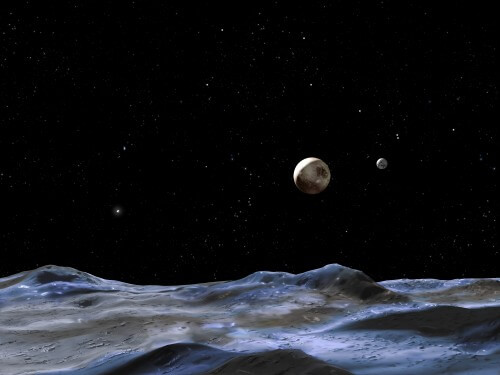In any case, this is a period at the beginning of the formation of the solar system, due to the tidal power of Pluto and Charon until their orbit in the frozen region stabilized

If the surface of Pluto's moon Charon is cracked, analysis of the crack's shape and composition could reveal if the moon's interior was hot, perhaps hot enough to sustain a subsurface ocean of liquid water. This is according to a new study funded by NASA.
In a separate news release, NASA reports that after weighing the scientific benefits, the Time Allocation Committee operating in the Hubble Space Telescope Administration has decided to use the space telescope to search for additional objects for the New Horizons mission, which is scheduled to fly by the Pluto system and its moons in July 2015.
The planned search will be done by focusing the telescope on small areas in the sky in search of a Kuiper Belt object (KBO) so that the spacecraft can visit them. The Kuiper Belt is a vast field of space debris and icy bodies left over from the process of the creation of the solar system about 4.6 billion years ago.
But even before finding more dwarf planets, New Horizons has enough work to do in the system of Pluto and its moons. The dwarf planet Pluto is a very distant world from the Sun, orbiting it at a distance 29 times greater than that of Earth. With a surface temperature of minus 229 degrees Celsius, Pluto's environment is too cold to allow liquid water to exist on the surface. The same is true of Pluto's moons.
Pluto's remoteness and dimness make it difficult to observe, but in July 2015 the New Horizon spacecraft will arrive for the first visit of Pluto and Charon and will provide the most detailed observations to date.
"Our model predicts different shapes of the cracks on Charon's surface depending on the thickness of the ice layer, its internal structure and how easily the formations change, and how Pluto's highly elliptical orbit affects that," said Alisha Roden of NASA's Goddard Space Center in Maryland. "By comparing the observations that the New Horizons spacecraft will make of Charon with several predictions, we will be able to see which model is more appropriate and find out whether Charon could have had a liquid subsurface ocean in the past." Rodan is the lead researcher in the study published in the journal Icarus.
Some moons surrounding the gas giants in the outer solar system are covered with cracks that indicate an internal ocean, for example Jupiter's moon Europa and Saturn's moon Enceladus.
As Europa and Enceladus move in their orbits, the gravitational struggle between the planet they each orbit and the neighboring moons causes their orbits to be elliptical rather than circular, which causes daily tides, which bend the surface and stretch the surface. It is believed that tidal heating extended the life of the subsurface oceans by keeping the surface of the Moon warm. In the case of Charon, the moon is relatively large relative to the size of the planet it orbits - an eighth of the mass of Pluto, a record in the solar system (in second place is the pair of the Earth and the Moon) and therefore it is estimated that it was formed much closer to Pluto after the impact of a large body that blew materials off the surface of Pluto . The materials rose to the top where they collapsed under the force of their own gravity and formed Charon and several small moons.
In the first stage the tidal waves were so heavy on both worlds, when the gravity of the two bodies caused the material on the surface of each of them to try to rise towards the other body, this created friction in the interior of both of them which led to the tide lagging slightly behind the orbital position. This lag acted like a brake on Pluto, causing its rotation to slow down while it transferred rotational energy to Charon which accelerated it away from Pluto.
"Based on the exact evolution of Charon's orbit, in particular if it went through a phase of great ellipticity, it may have had enough heat from tidal activity to keep water in a liquid state below Charon's surface for a period of time," Roden said. "A model of the interior structure that includes an ocean suggests that such an elliptical orbit is not required to cause cracks in its surface as we see in Europa."
"Because it is so easy for a planet to crack, but if we get to Charon and it appears that there are no cracks on its surface, this sets such a limit that the rate of ellipticity could have caused its interior to heat up" Roden added. "The research gives us theoretical preparation for the arrival of New Horizons, what to expect and what we can learn from it. Pluto is a fascinating body, and Charon is also going to be like that." concluded
For information on the NASA website
- In the same topic on the science website:
- New Horizons had brain surgery on its way to Pluto
- New Horizons Launch Report (2006)
- Pluto's fifth moon discovered (2012)
- Pluto has been demoted - from a planet to a new type of object: a dwarf planet

2 תגובות
great!
What an exciting time to live in. First spacecraft to Pluto, no less.
Aspire to NASA who have proven that the United States of America is not yet there!